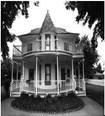Editor’s note: the language in this article is drawn directly from a 1966 thesis and reflects the terminology of that era, not the standing of this newspaper or the Ferguson Home Museum of today.
From TOLSON, Arthur Lincoln, 1924—2015. The Negro in Oklahoma Territory, 1889-1907; A Study in Racial Discrimination. The University of Oklahoma, Ph.D ., 1966 Leading up to the time of the appointment of Thompson Benton (TB) Ferguson as governor of the Territory of Oklahoma, there was considerable racial strife. “The genesis of trouble for the Negro in Oklahoma dates from the Run of 1889 and was due in part to white resentment at efforts by Negro leaders to colonize masses of their race in the new territory….” Racial bias was so strong by 1892 that according to reports there was not a single Negro in County G, and a mob at Lexington ran Negroes out of town. It was claimed that there was not a colored man in Blackwell, and Negroes reportedly were hounded by whites in Ponca City”.
The Indians opposed Negro migration to the territory, too. “In response to demands by Osage leaders, United States marshals ordered all Negroes out of Osage country. There was anti-Negro demonstration at Tecumseh during 1896, Pottawatomie County in 1898, Billings in 1899 and Stroud in 1901”.
In Blaine County where the Fergusons resided and ran the Watonga Republican, the Negro population was greater than any other of the counties in the 1892 run in the Cheyenne-Arapaho area: 1,106 Negro and 8,628 Whites. Perhaps this background prepared Ferguson to handle the racial strife during his term as territorial governor.
Governor Ferguson took office in late 1901 and scarcely four months later, “During the spring of 1902, Comanche County authorities wired Governor Thompson B. Ferguson … that private proclamations had been posted at Lawton warning all Negroes to leave town. In response to a request for aid by the territorial militia Ferguson promised that troops would be sent there to protect the colored citizens.”
“The Lawton disorders were vividly described by the Oklahoma Guide: Senator Stevens wired Governor Ferguson tonight that the town of Lawton, Comanche County, was in the throes of a race war and asked the executive to have troops in readiness to be sent there. When the Kiowa country was opened to settlement a large colony of Negroes were located there. Their numbers were augmented in December by emigration agencies in Mississippi and other Southern states, who shipped them by the carload to Lawton.
There were troubles between Blacks and Indians as well as Whites during T.B. Ferguson’s term as governor, “Nevertheless Negroes achieved some satisfaction with Governor Ferguson’s administration, because it was claimed that 'he had done a little more than any of his predecessors.'
“Thompson B. Ferguson, the sixth territorial governor, was well thought of by colored Republicans. The Western World said that he was a very approachable character, and that for this reason, colored Republicans constantly visited his office.”

